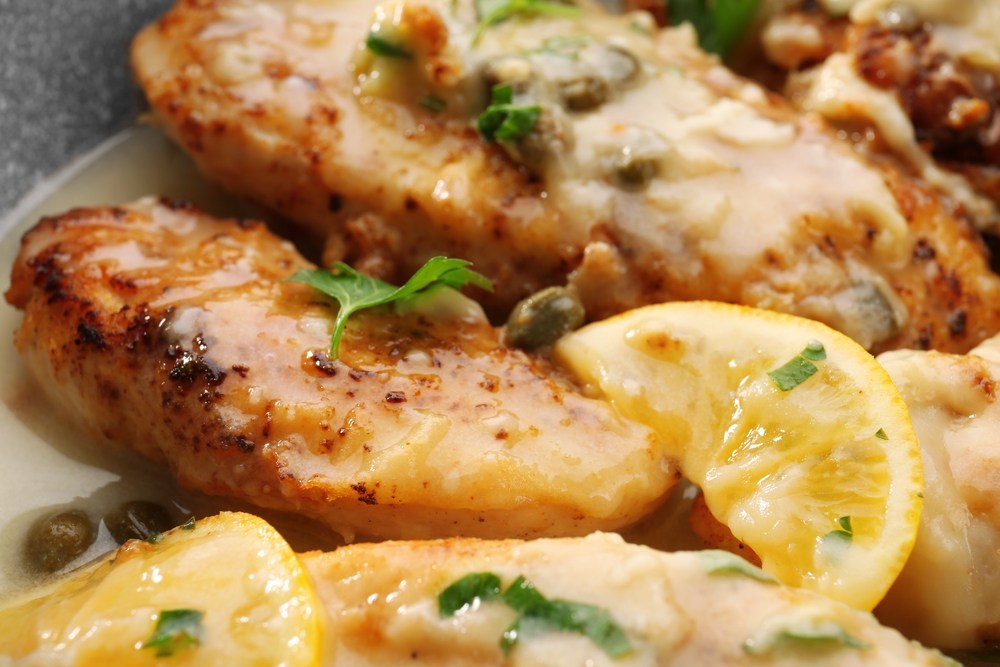
Wine Pairing: Louis Jadot Chardonnay & Chicken Piccata
Welcome to the WhisperKOOL blog! Twice a week, we’ll post informative articles about all things wine-related. Wine news, winery and vineyard info, helpful tips and tricks about storing, cooling, and transporting wine, and most delicious of all, wine and food pairings! We’ll share a recipe and a specific bottle of wine to pair with it. Fasten your seatbelts and get ready for a delicious duo: Louis Jadot Chardonnay and chicken piccata.
Let’s begin at the beginning:
THE RECIPE:
Chicken piccata is a delicious dish on a bed of veggies or cooked spaghetti noodles. Halved or butterflied chicken breasts (or chicken tenders) are breaded, cooked, and drizzled with a white wine and garlic sauce.
Ingredients
- 4 boneless, skinless chicken breast halves
- salt and black pepper to taste
- 1/3 cup flour
- 4 tbsp butter
- 4 tbsp olive oil
- 1/2 cup chicken stock or dry white wine (we used sauvignon blanc)*
- 2 tbsp lemon juice
- 2 tbsp shallots, chopped
- 3 cloves garlic, minced
- 2 tbsp capers, drained
- 2 tbsp chopped fresh parsley
Instructions
- Wrap each chicken breast in plastic wrap. Pound chicken breasts gently to a thickness of 1/4 inch. Sprinkle salt and pepper on both sides of chicken breasts. Put the flour in a bowl. Dredge the chicken breasts in the flour until well-coated. Shake off any excess flour.
- In a large skillet over medium-high heat, add two tablespoons of butter and two tablespoons of olive oil. Once the butter has melted, add the chicken and cook until it’s golden brown on the outside and cooked through on the inside. (Three minutes per side, approximately.) Remove chicken from heat and keep warm.
- Add chicken stock (or white wine), lemon juice, chopped shallots, and minced garlic to the skillet, along with the remaining two tablespoons of olive oil. Boil the sauce for about two minutes, until it thickens slightly. Add the remaining two tablespoons of butter and the capers.
- Put the chicken breasts on plates and pour the sauce over them. Garnish with the parsley as desired.
View recipe and nutrition facts here: https://www.deliciousmeetshealthy.com/chicken-piccata/
THE WINE:
We like making chicken piccata with sauvignon blanc or albariño, but we like eating it with a glass of Louis Jadot Mâcon-Villages Chardonnay. The Mâcon-Villages region of Burgundy is home to the tiny village of Chardonnay, and it the Mâcon-Villages appellation produces some of the best French Chardonnay. The winery called Maison Louis Jadot started in 1859 and its label, Louis Jadot, bills itself as America’s #1 French wine.
According to their website, Jadot Mâcon-Villages Chardonnay is completely unoaked to make sure that its delicate aroma and character—the character for which the Mâconnais region is renowned—is preserved. The terroir has a high concentration of chalk and limestone, so it imparts “nuanced minerality” to the wine. Made with 100% Chardonnay grapes, Mâcon-Villages has aromas of flowers, apples, and citrus fruits, and pairs well with goat cheese, crab cakes, and shellfish. Oh, and don’t worry—there’s a pronunciation guide on the website as well.
WHY THIS WINE PAIRS WITH THIS RECIPE:
That “nuanced minerality” makes Mâcon-Villages Chardonnay perfect for complementing a lightly spiced chicken dish with lemon and garlic sauce. The sweetness of the apple and citrus notes offsets the brininess of the capers and the tang of the fresh parsley. The fresh, clean flavor provides a welcome counterpoint to the savory breaded chicken and helps to enliven the palate after a big bite of buttery lemon, garlic, and olive oil piccata sauce. Overall, the combination of chicken piccata and chardonnay is good until the last bite (and drop).
If you liked our chardonnay and chicken combo, stay tuned for more delicious pairings coming your way on the WhisperKOOL blog. And don’t forget to check out our website for wine cooling units and accessories! See you next time!
A quick note about our capitalization of wine names…
We weren’t sure whether it’s “Sauvignon blanc” or “sauvignon blanc,” so we started scouring the Internet. We found an article in a 1985 issue of The New York Times Magazine which lays out the following rules:
- Capitalize wine names when the wine is named for a specific place and was created in that place. Hence, a burgundy from the Burgundy region of France would have its name capitalized as “Burgundy.”
- Do not capitalize wine names when the wine is named for a specific place but was not created in that place. A chianti not made in or near Chianti, Italy would not be capitalized.
- Don’t capitalize wines not named for places. “Sauvignon” is not the name of a city or a region, but probably originates from the French word for “savage.” Sauvignon blanc grapes grew wild in southwestern France before human beings cultivated them. Therefore, like The New York Times, we won’t be capitalizing the “sauvignon” part of sauvignon blanc.
- Wines which are named for places, but whose names have changed slightly “in transmission from place to wine” are not capitalized. For example, port takes its name from the Portuguese city of Porto, but nobody capitalizes the name “port”—nor sherry, even though the name derives from the city of Jerez in Spain.
- Wines like chardonnay, which are not named for a region but for a specific place within that region (in this case, the village of Chardonnay inside the Mâcon-Villages appellation of Burgundy, France) should be capitalized if they originate in that region. Louis Jadot Mâcon-Villages Chardonnay grows within the Mâcon-Villages appellation, so we’ve capitalized it in this article. When we talk about California chardonnay in later posts, we won’t capitalize it.
- Finally, wines named for grapes should not be capitalized unless the grape is named for a place and/or the wine originated in that place. Cabernet sauvignon is from the Bordeaux region of France. So if you have a Cabernet Sauvignon produced in Bordeaux, it should be capitalized. But cabernet is the name of the grape, not the city. Therefore it isn’t capitalized when you’re just generally talking about cabernet wine. Tokay is a town in Hungary, so the only time you should capitalize “Tokay” is if the wine originated there.



No Comments